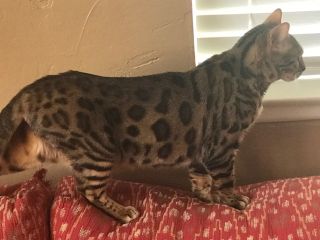Animal Behavior
Hospice in Veterinary Medicine
Personal Perspective: Hospice as a humane alternative to euthanasia for pets.
Posted May 17, 2024 Reviewed by Davia Sills
Key points
- In the veterinary field, home hospice was not traditionally a recognized treatment option.
- Hospice for pets remains in its infancy and is minimally available.
- A vet hospice team is a veterinarian, a technician, a counselor, the pet's family, and potentially clergy.
- Hospice care differs from palliative care because the hospice team provides rigorous support to the family.

Cranberry has leukemia. An alarming diagnosis and poor prognosis that started so simply.
“Something is wrong with her” was how the conversation started.
Cranberry was my beautiful Bengal kitty, an unlikely rescue, gifted to me by someone who couldn't keep her. Despite her exotic "jungle kitty" appearance, she had a sweet temperament and a velvety coat with the typical Bengal round rosettes. She was eating, drinking, and using the litter box normally. Her stools were fine, and she had no wounds, no vomiting, and no urinary or respiratory signs, but I still knew something was “off.”
You could always find her lying in a sunbeam, slowly migrating around the living room as the sun moved throughout the day. That was her pattern for the last 10 years until the morning it wasn’t. Immediately, I knew something was wrong.
I brought her to the hospital with me and did a full workup: bloodwork, x-rays, and urine. Diagnostics trickled in over the next four hours while I tended to other patients. I refused to worry until another doctor handed me her lab results. She passed me the papers with a shaky voice, “I’m so sorry.”
Denial is our protective mechanism to blunt the pain of bad news. Unfortunately, medical training overrides this.
Her complete blood count (CBC) showed exponentially high white blood cells with inappropriately low red blood cells and platelets. I blinked back tears as my mind slowly processed the numbers in front of me and what they all meant.
Pushing back against technology, I ordered a pathologist’s review. I demanded human eyes look at each cell in the CBC—hoping it was a machine error. An hour later, the pathologist’s report was clear: The machine was right. Basically, Cranberry’s white blood cells were taking over her bone marrow and suffocating all other cell lines. Cranberry had leukemia.
My beautiful girl was sick, really sick. Now I had a choice: What do I do next?

Traditionally, there have been two courses of action: treatment or euthanasia. If I chose treatment, she would have general anesthesia, a painful bone marrow aspirate, and then a chemotherapeutic protocol based on the results. She would come to the hospital every week for chemotherapy for several weeks. She would have IV catheters placed, blood drawn, and sit in a cage while chemotherapeutic agents dripped into her bloodstream.
While I knew that was the best medicine, it didn’t sound like a treatment I wanted her to endure. She is shy, hides from guests, and isn't stoic. Even trimming her nails caused dramatic yowls that sounded as though she were being tortured. She would hate to be poked by needles repeatedly.
Rejecting that treatment led me to the second traditional option: to put her to sleep, the euphemism for humane euthanasia. Yes, her prognosis was poor, and I was not going to put her through chemotherapy. But what if I wasn’t ready to say goodbye?
Then, I chose the option that has traditionally not been accepted or allowed in veterinary medicine: hospice.
Hospice care basically means accepting a cure is not attainable (for various reasons), and death is imminent in weeks to months. Given that short timeline, medications or treatments that may have unpleasant side effects are avoided. Instead of pursuing a cure, optimization of comfort and quality of life becomes the goal. And very much unlike chemotherapy, there is not a specific protocol; every pet’s treatment plan is individualized1.
Hospice is different from palliative care because it involves much more than just medications. Just like for human hospice, it is typically done at the patient's home, almost unheard of in small animal medicine. Additionally, the care plan necessitates 24-hour availability of the treating veterinarian, extended appointments so next steps can be discussed thoroughly and thoughtfully, and an atypical treatment team.
Veterinary hospice places a strong emphasis on the client-patient-veterinarian relationship, and individuals outside of the veterinary office are utilized, such as counselors, additional caregivers, and even clergy. Their role in the process is hospice assistance; they support the human, not the pet2. This level of commitment and involvement has historically been unrealistic for most veterinary practices to do, so it didn't exist.
Veterinary hospice is in its infancy now. Given I am a veterinarian, and so are most of my friends, we decided to do this for Cranberry and for me.
I brought Cranberry home and started her hospice care.
I noticed she was getting weaker and couldn't raise her paw high enough to enter the litter box. She has a box with the edges cut very low.
She didn't want her kibble. So instead, she is handfed cheap, wet cat food three times a day because she loves it. I am not going to battle her over eating healthy. I just celebrate every time she eats.
When she could no longer navigate the stairs, she was carried each morning to the living room and gently placed in a sunbeam. Once the sun goes down, she is carried back upstairs and tucked into her favorite soft blanket at the foot of our bed.
It is a blessing she isn’t in pain. With each passing day, I see she is weaker, becoming a shadow of her former self. Perhaps the best analogy for her process is a little light bulb that gets dimmer and dimmer. You know it will go out soon, but you just can’t bring yourself to give up on it.

I have no regrets about the care decision I made. I made that based on her needs, not mine. My needs are to have her be restored to her former glory or at least to stay with me for so much longer. That need is a fantasy and unrealistic. I can admit that and forgive myself for human frailty. If I put her through something painful, either physical or emotional pain, due to my selfishness, I could not forgive myself for that.
So we carry on, each day coaxing her to eat and carrying her to a sunbeam. I will do this as long as she holds on. When she tells me she is done with this routine, most likely by refusing to eat, I will give her a soft goodbye, and her little light that has flickered and fought will go out.
Hospice care, veterinary hospice, is the final gift I will give to both of us. I got to have more time with her than if I had immediately elected euthanasia for her terminal illness, and Cranberry got to feel like she was worshipped with no pain, no stress, and just the warm comfort of her favorite junk food and sunbeams.
References
1. Goldberg, Katherine J. (2016) Veterinary hospice and palliative care: a comprehensive review of the literature.VetRecord. 178, 369-374




